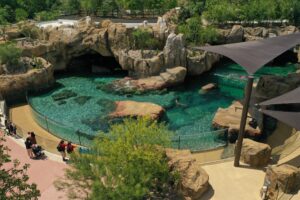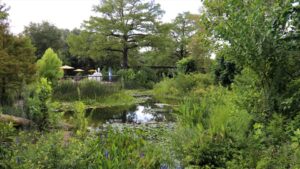While the Houston Zoo is well known for its animals, it considers the management of its buildings and site a critical part of its conservation mission.
The Zoo is located on 55 acres in Heman Park near the Texas Medical Center and Museum District. Over the years Houston Zoo has undergone enormous changes and growth. Roughly 1/3 of the Zoo has been renovated or rebuilt in the last five years through the Zoo’s centennial master plan. The Zoo’s latest brand-new exhibit, Galapagos Islands, is one of the final pieces of the plan, and it opened to great fanfare in April 2023.

The Houston Zoo’s Galapagos Islands Exhibit
While accommodating this growth Houston Zoo has set itself some ambitious sustainability goals designed to benefit the environment and help fulfill its mission to save animals in the wild. In 2017, it set the goal to “Operate Sustainably to Benefit the Environment.” This goal was further defined as “…minimize environmental impact, to conserve natural resources and to lead and inspire sustainability practices by guests, community organizations and businesses.”
To achieve this goal Houston Zoo has focused on three key areas: Water Usage, Energy Usage and Resilience.
In water usage Houston Zoo set an ambitious goal not to exceed the carrying capacity of their site, using no more water than falls on their 55-acre campus. This amounts to 71 million gal/yr, and the Zoo aspires to achieve this goal by 2030.
To achieve this goal Houston Zoo had to first understand its baseline water usage. The Zoo’s water usage was historically captured as a part of the overall Herman Park water usage, so one of their first goals was to install meters to identify what came and what went out of the Zoo property. In 2016, a baseline usage of 194 million gallons per year was established, but it was only after the completion of meter installations that Houston Zoo could accurately establish a water usage just for the zoo of roughly 93 million gallons per year. This was a great stride towards their goal.
With this knowledge, the Zoo set out to:
- Continuously improve monitoring of water consumption
- Use closed-loop systems with efficient filtration
- Detect and correct leaks
- Target better-than-code efficiency via low-flow fixtures on all new buildings
- Reduce irrigation
Houston Zoo believes that it is making strides towards achieving their sustainability goals with water usage, although they have a significant way to go. With a focus on reducing irrigation their progress to date has been promising by focusing on three key areas.

The Texas Wetlands Exhibit at the Houston Zoo
The first is through the use of Native Plantings, specifically planting native trees, shrubs, ground cover and grasses. This is both a goal to reduce water usage but also required for some biogeographic exhibits. Similarly, some exhibits cannot use Native Plantings for exactly the same reasons. Where native plantings have been introduced, they have proven successful enough to look at further areas to convert, particularly as a means to create habitat for pollinators and other beneficial insects. Some highlights at the Zoo are vegetated roofs of two kiosks that sell beverages and tickets, both of which have a native prairie wildflower mix, as well as three prominent pollinator gardens near the giraffe barn, Children’s Zoo area, and South America’s Pantanal exhibit.
The second is through the use of rain sensors to moderate irrigation usage. Houston Zoo recognizes that the use rainwater sensors are low hanging fruit in terms of water conservation, but their installation of sensors to date has proven very successful in reducing the amount of irrigation water used. Manufacturers claim the use of rain sensors give you a 10% to 20% reduction in irrigation water usage and the results from the Zoo appear to be supporting these claims. This combined with a transition to drip irrigation, bubblers, and efficient micro spray systems have shown very promising results.

The McGovern Front Plaza
The final initiative is to collect and reuse rainwater. The initial installation of rainwater collection for irrigation has primarily been used in the back areas of the Zoo to assist with irrigation and washdown of animal areas. To date above-ground tanks ranging in size from 5,000-25,000 gallons have been used to collect rainwater for irrigation, and the results have been sufficiently positive to look at larger and more ambitious opportunities for rainwater harvesting, including in public areas. Several upcoming projects feature public-facing rainwater collection and reuse systems.
The Zoo hopes its sustainability efforts will serve as a model for the general community. With incentives for green infrastructure, many developments are either integrating or considering integrating some of the same strategies adopted by the Zoo. From residences to campus master plans, the Houston Zoo has taken a significant step in demonstrating what can be achieved and what should be encouraged within the wider development community.
The Houston Zoo has set itself an ambitious goal for sustainability through water conservation and are working steadily towards their 2030 goal. Will they achieve their goal? You will have to visit to Zoo to find out for yourself.

Written by Maurice Mullaly
Sustainable Infrastructure Committee
Published November 1, 2023
